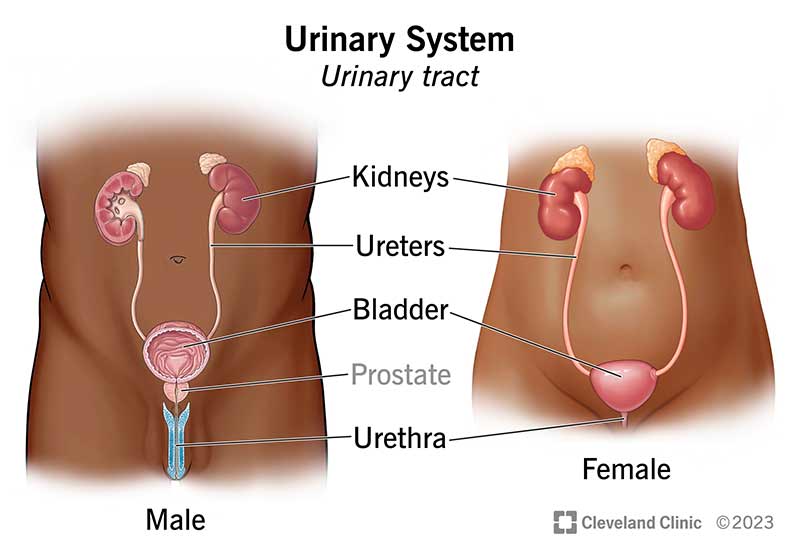The urinary system includes your kidneys, ureters, bladder and urethra. This system filters your blood, removing waste and excess water. This waste becomes pee. The most common urinary issues are bladder infections and urinary tract infections (UTIs).
Advertisement
Cleveland Clinic is a non-profit academic medical center. Advertising on our site helps support our mission. We do not endorse non-Cleveland Clinic products or services. Policy

The urinary system (or urinary tract) works as your body’s filtration system. When your urinary system removes toxins and wastes from your body, it comes out as pee (urine). To be able to pee, your body must pass this waste through a series of organs, ducts and tubes. If there’s a problem at any step in this process, it can affect if you’re able to pee normally.
Advertisement
Cleveland Clinic is a non-profit academic medical center. Advertising on our site helps support our mission. We do not endorse non-Cleveland Clinic products or services. Policy
The main organs in your urinary system are:
Your urinary system filters your blood to get rid of what your body doesn’t need. It eliminates extra water and salt, toxins and other waste products. Different parts of the urinary system perform tasks, including:
Your kidneys are an essential part of filtering your blood. Here’s how the urinary system works:
The kidneys, ureters, bladder and urethra make up the urinary system. They all work together to filter, store and remove liquid waste from your body. All of the organs in your urinary system are in your abdominal and pelvic region.
Advertisement
Here’s what each organ does:
Many conditions can affect your ureters, kidneys, bladder and urethra. Infections, diseases or problems can appear at birth or develop as you get older. Cancer can also affect certain parts of your urinary tract.
Some common urinary disorders are:
Urinary tract infections and sexually transmitted infections (STIs) can cause issues with your kidneys, urethra or bladder. These infections occur when bacteria enter your urinary tract through your urethra. Your healthcare provider can prescribe medication (typically antibiotics) to treat an infection.
Kidney stones are small masses that form when waste products clump together. Kidney stones or ureteral stones (kidney stones that move to your ureter) can cause severe pain and block the flow of pee.
Loss of bladder control or urinary incontinence (leakage), causes pee to leak when you don’t want it to. It can be worse when you cough, laugh, sneeze or jump. Overactive bladder happens when you feel the sudden urge to pee more often. Urinary retention is a condition where your bladder doesn’t completely empty each time.
Many of these conditions consist of lower urinary tract symptoms like an urge to pee, a weak urine stream and leaking pee. Medications and lifestyle modifications can help treat these conditions.
Growths or tumors in any part of your urinary tract can affect the flow of pee. An enlarged prostate can block your ureter so it’s harder to pee. Other causes of ureteral obstruction include pregnancy and gastrointestinal (GI) issues like Crohn’s disease. Bladder outlet obstruction can also happen and prevent your bladder from emptying. Surgery can often help with obstructions in your urinary tract.
Advertisement
Kidney disease is a common and serious condition that affects your urinary system. The most common causes of chronic kidney disease (CKD) are high blood pressure and diabetes. Managing blood pressure and blood sugar is crucial to lowering your risk of kidney disease. Kidney disease can lead to kidney failure. Kidney failure may require dialysis or a kidney transplant. Talk to your healthcare provider about your risk for kidney disease so you can take steps to lower your risk.
Also called painful bladder syndrome, this condition causes inflammation in your bladder. Medications and physical therapy can improve the symptoms of painful bladder syndrome.
Sometimes, babies are born with conditions that affect the way their urinary tract forms. For example, an ectopic ureter is when your child’s ureter connects to a place other than their bladder. Other urinary system organs can be underdeveloped, which can lead to issues with peeing.
A bladder prolapse is when your bladder drops into your vagina or hangs out of your vaginal opening. Sometimes surgery is required to fix the problem.
Symptoms vary depending on what condition you have. Many conditions share similar symptoms, like:
Advertisement
The tests your healthcare provider will order to diagnose a condition affecting your urinary system depend on your symptoms and other factors. Some tests you may need to have include:
Advertisement
The most common urinary issues are urinary tract infections (UTIs). More than 60% of females will get at least one UTI in their lifetimes.
More than half of those who’ve given birth will experience urinary incontinence in their lifetimes, usually due to their pelvic floor muscles stretching.
Kidney stones are also fairly common, occurring in about 1 in every 10 people.
About 37 million people in the United States are living with chronic kidney disease.
You can try to keep your urinary system healthy with proper hygiene and a healthy lifestyle. To help your urinary system work the way it should, you can:
You should contact your healthcare provider if you’re having trouble or pain when you pee. It may be a sign of an infection or another condition. Call your provider if you have:
Your urinary system plays a critical role in keeping you alive. It filters your blood and removes waste and excess water through your pee. Your urinary system includes your kidneys, ureters, bladder and urethra. Conditions like urinary tract infections (UTIs), sexually transmitted infections (STIs), kidney diseases and urinary tract obstruction can affect the health of your urinary system. If you have one of these conditions, talk to your healthcare provider about steps you can take to stay healthy.
Cleveland Clinic’s primary care providers offer lifelong medical care. From sinus infections and high blood pressure to preventive screening, we’re here for you.

Last reviewed on 06/13/2023.
Learn more about the Health Library and our editorial process.